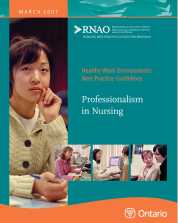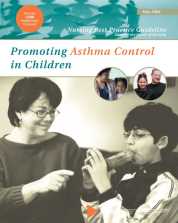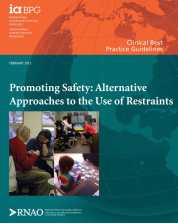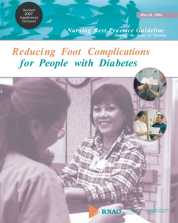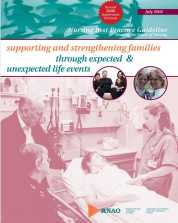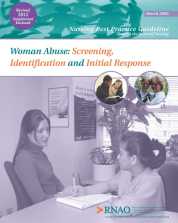This best practice guideline (BPG) focuses on bladder and bowel management in adults (aged 18 years and older).
The purpose of this best practice guideline (BPG) is: to identify the concept of professionalism as a guiding tenet that enhances outcomes for nurses, patients, organizations and systems; to define the attributes of professionalism; to identify and discuss the evidence related to each attribute of professionalism; and to provide strategies for success.
The guideline contains recommendations for registered nurses and registered practical nurses on best nursing practices in the area of paediatric asthma. It is intended for nurses who may not be experts in asthma care and who work in a variety of practice settings across the continuum of care.
The purpose of this best practice guideline (BPG) is to provide evidence-based recommendations for registered nurses (RNs) and registered practical nurses (RPNs) related to the care of individuals who are at risk for behaviours that may result in harm to self/others and lead to the possible use of restraints (physical, chemical, environmental). Unless otherwise indicated in the guideline, the discussion focus is on physical restraint.
The purpose of this best practice guideline (BPG) is to support nurses as they help people with diabetes reduce their risk of foot complications.
The purpose of this best practice guideline (BPG) is to assist nurses in promoting family health through interventions and supports provided during expected as well as unexpected life events. Expected life events may include birth, school, adolescence, aging, and death, while unexpected life events may include trauma/accidents, chronic illness, developmental delay and disability.
The purpose of this best practice guideline (BPG) is to provide nurses and the interprofessional team with evidence-based recommendations for the most effective strategies to support adults (18 years and older) who anticipate or live with an ostomy that will:
(a) promote self-management,
(b) enhance access and delivery of care, and
(c) lead to positive health outcomes.
The purpose of this best practice guideline (BPG) is to provide nurses (nurse practitioners, registered nurses, registered practical nurses and nursing students) and other members of the interprofessional team with evidence-based recommendations and resources related to the insertion, assessment and maintenance of vascular access devices (VADs) in the infant (0–1 year), pediatric (1–18 years) and adult populations (18 years and older).
The overall purpose of this guideline is to facilitate routine universal screening for woman abuse by nurses in all practice settings.
